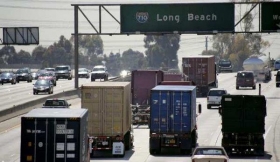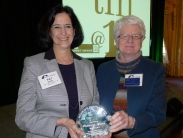Jennifer Chheang, a Program Manager at the California Endowment, authored this blog post.
The upcoming widening of the Panama Shipping Canal is causing a global stir, one felt especially in California, where more than half of all imported shipping containers enter the U.S. The fear of losing competitiveness to newly accessible East Coast ports has those on the West scrambling to expand their ability to accommodate super-tankers and efficiently transport consumer goods from ships to trucks and rail, a process also known as the “goods movement.” Dredging our oceans and widening our superhighways is viewed as the price of participating effectively in the global economy, but is it the only option? Faced with a proposed multi-billion-dollar expansion of the freeway that runs through their community, residents of Long Beach, California and the Long Beach Freeway Corridor decided to find another path.
Long Beach is part of the country’s largest shipping complex, consisting of the Ports of Los Angeles and Long Beach. Between the rail yards of East Los Angeles and the two ports is the 24-mile stretch of the I-710 freeway. In order to accommodate projected truck traffic traveling to and from the ports, a $15 billion freeway expansion is under consideration. The proposal would potentially double the width of the freeway from 8 lanes to 16 – making this the single largest infrastructure project currently under review in the country.
Current health impacts from diesel truck traffic on the I-710 already threaten the well-being of those who live along the corridor. Residents there suffer disproportionately from asthma, cancer and other conditions related to air pollution. Soot blankets the windowsills in even the wealthiest areas of Long Beach and the closer to the freeway, the worse things are.
At The California Endowment, we are in the third year of a ten-year investment to improve health outcomes in Long Beach by improving neighborhood conditions. A quick drive through West Long Beach reveals what we all know: too often land-use planning does not place people at the heart of decision-making. So when residents and community groups learned of the proposed I-710 expansion, they knew that without community involvement and organizing, the project might meet the needs of shippers and truckers, but would not address the needs of the people who living in 710 corridor communities.
Together, concerned residents and organizations formed the Coalition for Environmental Health and Justice (CEHAJ), which has worked intensively to ensure the needs of community residents are included through holistic design. The group pushed Caltrans to include a Health Impact Assessment (HIA) in order to quantify the health impacts of the 710 Corridor Project in the Draft Environmental Impact Report (DEIR). However, when the DEIR was finally released at a whopping 10,000 pages, advocates knew they needed help to review the document and offer input that was taken seriously. A rapid response by local funders, including The Endowment, assisted CEHAJ in hiring technical experts to provide comments on the DEIR. And rather than simply respond to Caltrans proposals, CEHAJ worked with these experts and community residents to develop an alternative scenario that incorporates the community’s vision. This alternative is called theCommunity Alternative 7 (CA7).
CA7 envisions a different future for the I-710 corridor: one with zero-emissions trucks, greater investment in public transit, better access to open space and parks, and an improved LA River. Local residents would be hired for local jobs, and there would be expanded opportunities to walk and bike safely. In short, a project built for people, not trucks.
As a result of community organizing efforts, the 710 Project Committee made up of local elected officials voted to include the CA7 as an official alternative of the 710 Corridor Project. If the CA7 is chosen as the final plan for the expansion project, it can serve as a model of what can be done to create projects that support port growth while placing a premium on local health.
The project has not yet crossed the finish line and much work remains. But this case serves as a valuable example of how funders can play a critical role in holding public systems accountable to considerations of community health in development projects. The use of HIAs makes health impacts visible and the funding of technical experts ensures these inputs are taken into account in the planning process. Local government is only as accountable as the community itself can make it. Through the effort and dedication of local residents, authentic needs may surface and be held up as too important to ignore.
To hear more about the I-710 freeway project and philanthropic efforts to ensure smarter and healthier growth on massive infrastructure projects, please join me on an October 25 webinar for funders co-sponsored by HEFN, the Funders Network for Smart Growth and Livable Communities, and the Environmental Grantmakers Association. More details and registration information are available here.
Jennifer Chheang, a Program Manager working on the California Endowments’ Building Healthy Communities (BHC) initiative, authored this blog post. She manages the Endowment’s Long Beach BHC site.



